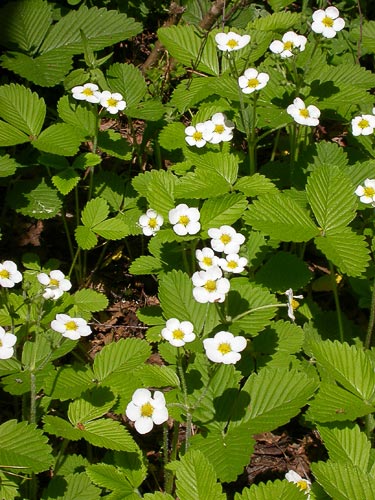Relatives
Fragaria moschata (Duch.) Weston - Hautbois strawberry, garden strawberry
Taxonomic position.
Family Rosaceae Juss. genus Fragaria L.Synonyms.
Fragaria elatior Ehrh., F. reversa Kit., F. moschata f. rubiflora Heimerl, F. vesca var. pratensis Ait., F.magna Thuill.Morphology and biology.
Perennial herbaceous plant. The stem is erect, 15-40 cm high, notably longer than the bottom leaves assembled in a rosette. Runners are often absent. The stem and leaf stalks are covered with dense horizontally squarrose simple and glandular hairs. Leaves are large, ternate-compound; their ovate-rhomboid leaflets on short petioles are large- and broad-toothed, pilose from above, while densely silky-pilose and glaucously green from below, with protruding veins. Inflorescence is corymbiform, consisting of 5-12 flowers with short densely and squarrosely pilose pedicels, considerably accrescent after the end of blossoming and clad in declinate hairs. Flowers are large, up to 2.5 cm in diameter, usually unisexual, often dioecious. Sepals are linear-lanceolate, much shorter than the petals, appressed pilose, but under fruit squarrose or declinate. Fruits are ovoid or spherical, tapered at the base in a coccus-free collar, white, greenish-white, reddening only from one side, pinkish or less frequently red, detachable from their receptacles with difficulty. Cocci are naked, submerged. Entomophilous. Ornito- and zoochore. Blossoms in May, bears fruit in July. 2n = 42.Distribution.
In the European part of Russia (from Karelia and Vologda Province in the north down to Rostov Province and the Caspian Sea in the south) and the Ukraine; infrequently occurs in the Crimea and the Carpathians as well as in the Caucasus (western part of Ante-Caucasus, Great Caucasus and Trans-Caucasus). Its habitats in Siberia are isolated from the main area of distribution and not numerous (Tyumen Province - vicinities of Tyumen, Tomsk Province, Omsk Province - vicinities of Omsk, Altai Region - vicinities of Barnaul and Belokurikha, Republic of Altai - vicinities of Abai Village and Balyktuyul Tract, Khakassia - vicinities of Uzunchul Settlement and Shira Lake). Scandinavia, Central Europe, Atlantic Europe, occasionally Mediterranean Region.Ecology.
Mesophyte. Grows in forests and bushes, on forest borders, open grassy hillsides and meadows, usually in shadowy places and tall grass; spread from the lowlands to the middle mountain belt. Prefers sufficiently moistened fertile soils.Utilization and economic value.
Food (berries) and medicinal. Fruit are edible fresh and used to prepare jam and confectionary. Its cultivation started a long time ago. Wild forms may serve as a valuable source for breeding because they are more winter-hardy than many cultivated varieties.References:
Areas of distribution of medicinal plants and their relatives in the USSR (Atlas). 1990. Schmidt's V.M. (ed.). Leningrad: Leningrad University Publishers, 2nd edition (revised), p.60. (in Russian).Brezhnev, D.D., Korovina, O.N. 1981. Wild relatives of cultivated plants in the flora of the USSR. Leningrad: Kolos, pp. 203-204. (in Russian).
Brummitt, R.K. & C.E. Powell (eds.) Authors of plant names. Royal Bot.Garden Kew Kew 1992: 732 pp.
Flora of Siberia. Rosaceae. 1994. Malyshev's L.I., Peshkova's G.A. (ed.). vol. 8. Novosibirsk: Nauka, p. 34. (in Russian).
Mansfeld's World Database of Agricultural and Horticultural Crops http://mansfeld.ipk-gatersleben.de/
Poyarkova, A.I. 1941. Strawberry - Fragaria L. (Flora of the USSR.) Moscow/Leningrad: Publishing House of the USSR Academy of Sciences, vol. 10, pp. 60-61. (in Russian).


